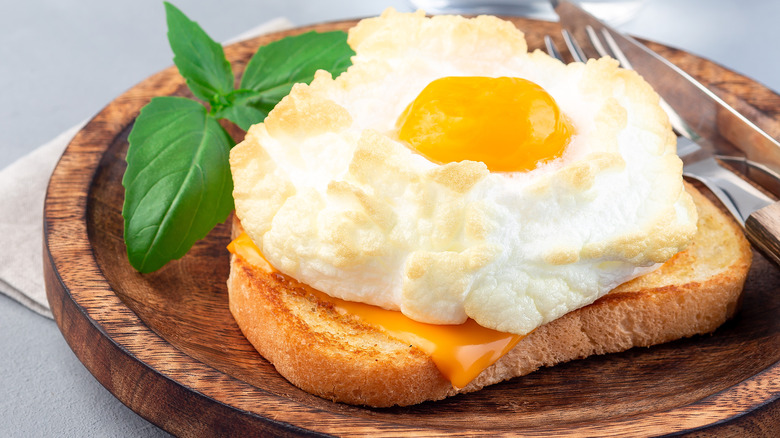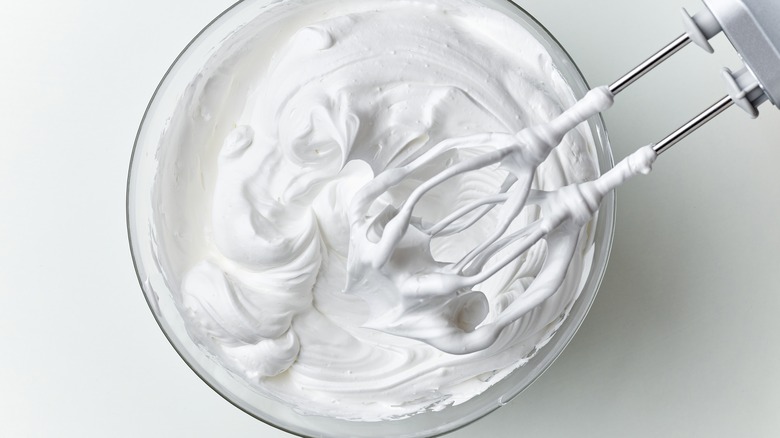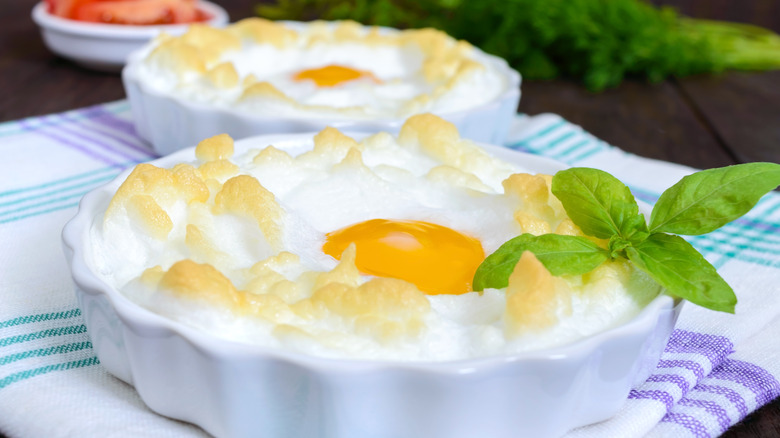The Key To Making Fanciful Cloud Eggs And Winning Brunch
Brunch goes beyond a simple everyday breakfast or a hastily grabbed bun as you dash out the door. It's more like slowly welcoming a new day in the relaxed company of good friends or treasured family. There are plenty of go-to brunch favorites, from comfort-food scrambles to dainty pastries and plenty of fresh fruit. But if you really want to win brunch, both visually and "oh-wow" deliciously, try your hand at the fanciful French egg dish with a name to suit. It goes by several monikers, most commonly "cloud eggs," but also "eggs in the snow" or "eggs in a cloud."
Cloud eggs get their name from the finished appearance, which undeniably mimics fluffy white cumulus clouds billowing on your plate. The center glows with bright orange egg yolk, creating a visual of airy clouds framing a midday sun. While more than earning a central showcase spot on your brunch table, they also happen to be sky-high on the tastiness scale. The ingredient list for traditional cloud eggs is a minimalist chef's dream, basically consisting of eggs, salt, and pepper to taste. But of course, customizing considerably broadens your options.
How to make cloud eggs
Creating your own version of cloud eggs is quick and easy, though it does take a gentle hand to separate the egg yolks from the whites and to whip the latter into fluffy mounds. The entire process should only take about 15 to 20 minutes, including bake time. Since you're serving brunch to several people, devote at least 8 eggs to this art-on-a-plate endeavor.
Separate the yolks from the whites, placing each in a separate bowl. Be sure to keep the yolks intact, as that's where you'll get the fully rounded "sun" in the middle of your egg-white "clouds." As a precaution, you could just place each egg yolk into its own miniature bowl.
Add a pinch of salt and pepper to the egg whites, then use a whisk or handheld mixer (for large batches) to create fluffy peaks. Scoop mounds of the pillowy beaten whites in sections onto a lightly greased baking sheet, and use the back of a spoon to make center indentations in each one, like a simulated bird's nest.
Bake at 400 degrees Fahrenheit for about 5 minutes, until slightly firm and lightly brown, then remove from the oven and slide an egg yolk into each nest. Return to the heated oven for another 3 to 5 minutes, depending on how well done you like the yolks. That's the basic idea, but experimenting with additional ingredients might just add some heavenly flair.
Customize clouds eggs with your own interesting tweaks
The sky's the limit when it comes to customizing cloud eggs, though you do want to steer away from adding heavy ingredients that could deflate your egg-white nests. A good place to insert some extra tastiness is just after beating the whites into their stiff peaks. Think light complementary additions such as diced, pre-cooked peppers, herbs, grated Parmesan or other cheeses, bacon, ham, prosciutto, or even flaky bits of smoked salmon. You don't want anything that requires extra time to cook.
To elevate the presentation of cloud eggs for your brunch event, consider making each one individually in its own pan. Tart pans with fluted sides add a touch of elegance while also providing support for the egg whites as they cook. Top with chives, fresh basil leaves, or other greens for an earthy juxtaposition to the sky-centric theme. This dish is also a good contender for those breakfast-for-dinner days when the mood strikes.
Don't be timid about putting your own touch on this centuries-old recipe, originating in 17th-century France. The dish first appeared in a 1651 French cookbook under the name of "Oeufs à la neige," which translates in English to "eggs in the snow." After almost 400 years, it's surely justified for creative cooks around the world to deviate from the original recipe. After all, the originals required baking over hot coals and browning overhead with a heated paddle-style salamander tool.



